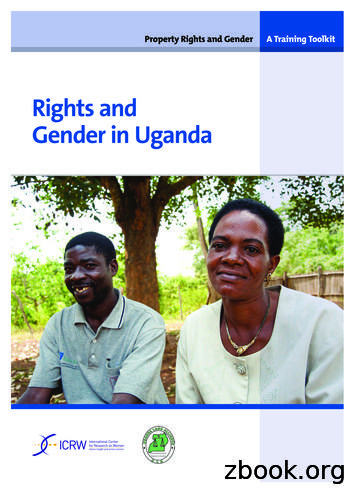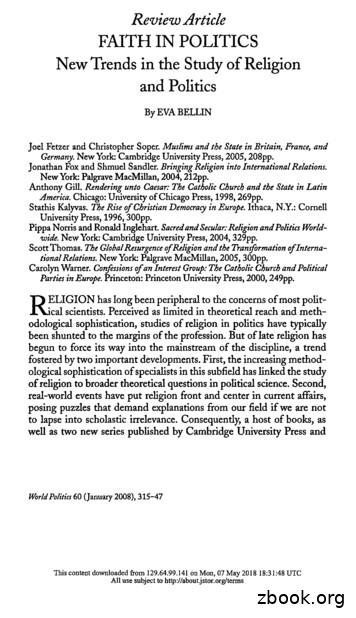Crabgrass-Roots Politics: Race, Rights, And The Reaction .
Crabgrass-Roots Politics: Race, Rights, and the Reaction against Liberalism in the UrbanNorth, 1940-1964Author(s): Thomas J. SugrueReviewed work(s):Source: The Journal of American History, Vol. 82, No. 2 (Sep., 1995), pp. 551-578Published by: Organization of American HistoriansStable URL: http://www.jstor.org/stable/2082186 .Accessed: 27/09/2012 13:32Your use of the JSTOR archive indicates your acceptance of the Terms & Conditions of Use, available at ms.jsp.JSTOR is a not-for-profit service that helps scholars, researchers, and students discover, use, and build upon a wide range ofcontent in a trusted digital archive. We use information technology and tools to increase productivity and facilitate new formsof scholarship. For more information about JSTOR, please contact support@jstor.org.Organization of American Historians is collaborating with JSTOR to digitize, preserve and extend access toThe Journal of American History.http://www.jstor.org
Politcs:Race,Rights,Crabgrass-Rootsand the ReactionagainstLiberalismin the UrbanNorth,1940-1964ThomasJ. SugrueThe UnitedStateshistoryandof a triumphantliberalstate,shaped bythehopefulmarriageof iseandvalidatedbya "liberalconsensus"criticsofthewhitesand Blacks,CatholicsandJews.Conservativeand northerners,has recentlyas Alan Brinkleyofhistoriography,statehaveremainedon thefringesAmerica."Oneargued,a of theunexaminedironiesof recentAmericanhistoryis calrightistas theLibertyLeague,theBlackLegion,and theorganizationsJohnBirchSociety,nor fromthe ranksof Communistsand socialists.The most- came fromchallengeto liberalismvocal- and ultimatelythe farthest-reachingdie-hardDemocratswithintheNewDeal tion.CorpoconstrainedordisaffectedNewDeal sand businessunionistslimitedthe possibilitiesin theworkplace.Theirstoriesare wellknown.But crucialto the fateofreformUnitedStateswerenorthin themid-twentieth-centuryliberalismand ftheNewDeal coalition;theirpoliticalin themid-twentiethofliberalreformviewsand iltheleadingliberalsocialmovement,and constrainedcentury1rightsand libertiesto ugrueisassistanta ienceAssociationwerepresentedto rmanto Dana Barron,andcollegialD.C. lisonIsenberg,ArnoldR. htenstein,Jameson chigan;Foundation;UniversityLibrary,theWalterP. ReutherGrantfromtionResearchLibrary.' AlanBrinkley,99 emofAmericanConservatism,"inofU. S. ConservatismRight:New Historiesreviewessay,MichaelKazin, "TheGrass-RootsSee alsotheimportantibid., 97 (Feb. 1992), 136-55. On southernwhitesand theroleof southernDemocratsCentury,"theTwentiethThe Journalof AmericanHistorySeptember1995551
552ofAmericanHistoryTheJournal1995SeptemberThe New Deal mayhave been, as LizabethCohen and othershave argued,aat leastin theurbanNorth.Indusunifyingmomentin algoalsin hroughthe Congressof IndustrialOrganizations(cio), and expressedtheirgrievancesYet beneaththethroughan inclusivelanguageof Americanism.seemingunityof theNew Deal orderwereunresolvedquestionsof racialidentityand racialpolitics.Eatingawayat the "liberalconsensus,"just as it reacheditsworking-classwhiteness.2As earlyas thepostwarapotheosis,wasa newlyassertiveissuesin theurbanNorthbeganto ivatedurbanworking-classand middle-classwhitevoters.In formation,northerncitiesundergoingwitha growingskeptitheyfashioneda newpoliticsthatcombinedracialantipathycismabout liberalism.The whiterebellionagainstthe New Deal had its originsin theurbanpoliticsofthe 1940sand 1950s.The localpoliticsofraceand housingin theaftermatha grass-rootsrebellionagainstliberalismofWorldWarII fosteredof theNewand seriouslyand Deal order.PostwarDetroitat theThe historyof politicsin the post-NewDeal era has been told primarilythatformedthepoliticalnationallevel.The values,ideals,and socialmovementsworldofthemid-twentiethcan be seenmostclearly,centuryhowever,at evel,wherepoliticalandsocialhistoryAn examinationAmericans.ofpost-WorldWarII Detroit,Michigan,offersinsightslevel. Dominatedby a blue-collarintothe travailsof liberalismat the grass-rootsworkforce,heavilyunionized,and predominantlyCatholic,Detroitwasa strongDetroithold of theDemocraticparty,a bastionofsupportforNewDeal liberalism.- bothwhiteandBlack- benefitedfromNewDeal programs.workerstremendouslyworkduringthe GreatDepression,the WorksProgressBy providingtemporaryseeJamesC. Cobb and MichaelNamorato,eds., TheNew Deal and thein limitingNew Deal socialprograms,South (Jackson,1984). On the post-WorldWarII South,see Numan V. Bartley,FromThurmondto Wallace:PoliticalTendenciesin Georgia,1948-1968 (Baltimore,1970); Jill Quadagno, "FromOld Age AssistancetoSupplementalSecurityIncome:The PoliticalEconomyof Reliefin the South, 1935-1972,"in The PoliticsofWeir,Ann Shola Orloff,and Theda Skocpol(Princeton,1988),Social Policyin the UnitedStates,ed. Margaret235-64; and BruceJ. Schulman,FromCottonBelt to Sunbelt:FederalPolicy,EconomicDevelopment,and thein theworkplace,see NelsonTransformationoftheSouth,1938-1980(New York,1991).On thelimitson reform"FromCorporatismto CollectiveBargaining:OrganizedLaborand theEclipseof SocialDemocracyLichtenstein,in thePostwarEra," in TheRiseand Fall of the New Deal Order,1930-1980,ed. SteveFraserand ton Labor(Princeton,1989), 122-52; and ElizabethA. Fones-Wolf,and Liberalism,1945-60 (Urbana,1994).2 LizabethCohen, Makinga New Deal: IndustrialWorkersin Chicago,1919-1939 (New York,1990); GaryAmericanism:ThePoliticsofLaborin a TextileCity,1920-1960(New York,1989); GaryGerstle,Working-ClassHistory,44 (FallLaborand Working-ClassRacism:Broadenthe Focus,"InternationalGerstle,"Working-Class1993), 33-40; BruceNelson,"Class,Race,and Democracyin theCIm: The 'New' LaborHistoryMeetsthe'WagesDavid Roediger,Towardsthe Abolitionof Whiteness,"'InternationalReviewof Social History(forthcoming);ClassHistory(London,1994).of Whiteness:Essayson Race, Politics,and Working
ntedthe loyaltyof the unemployedof all racesto the NewAdministrationDeal. The NationalLaborRelationsAct of 1935 o Detroit'sblue-collarpopulation.By the ghwagesand s,underthe aegis of the Home HousingAdministration,Corporation,and made home ctedmuchof the edout in . Roosevelt,everyelectionafter1932, most prominentlythe city.clubs, bars,and ctionsfortheprovidedthe crucialmarginof votesin gubernatorialDetroitersNew Dealer FrankMurphy(laterappointedto theUnitedStatesSupremeCourtby FDR) and forliberalssuch as G. Mennen"Soapy"Williams.Onlyonce afterButfailto id Detroitersjustas supportfortheNew Deal reacheditszenithat thestateand nationallevels,social and demographicchangesbegan to erode supportforthe liberalagendain uthernThe SecondGreatMigrationtremors.Detroitwas a magnetforAfricanAmericanmigrantsduringand afterWorldWarII. The usandbetween1940 and 1970,growingfrom9 percentof the city'spopulationin 1940manyof whomfoundstableandto 45 percentin 1970. AspiringBlackworkers,in thecity'sdefenseand mallandcrowdedinner-cityhad held mostof the city'sAfricanAmericanpopulationin 1940. In the ades,thecity'sracialgeographywhitesectionsof the city.PoorerBlackssoughtbetterhousingin predominantlyAfricanon therealestatemarket.Between1940and ricansmovedinto 110 previouslyIn the wakeof thisinfluxof Blacks,racialtensionsmounted.WorldWar IIa riotat the siteofbroughta waveof hate strikesagainstBlackdefenseworkers,TruthHomes,a publichousingprojectforBlacks,and the 1943racetheSojournerriot,the bloodiestcivildisorderin the UnitedStatessincethe draftuprisingsofthe CivilWar.AlthoughDetroitdid not experienceanothermajorraceriotuntilIsee MelvinG. Holli, ed., Detroit(New York,1976),274.of electionreturns,Fora distillation4U.S. Departmentof Commerce,Bureauof the Census, U.S. Censusof Populationand Housing, 1940,1942), table 1; U.S. DepartmentforDetroit,Michiganand AdjacentArea ureauoftheCensus,U.S. CensusofPopulation,1950, CensusTractStatistics,ofCommerce,and AdjacentArea (Washington,1952), table 1; U.S. Departmentof Commerce,Bureauof the Census,U.S.StatisticalCensusesofPopulationand Housing,1960, 962), tableP-i.PHC(1)-40 (Washington,Area, FinalReport
554TheJournalofAmericanHistorySeptember19951967, racerelationsin theperiodafterWorldWarII werenot tranquil.One cityracerelationsofficialcalled thepostwarperiod"thedarkages of Detroit."5PostwarDetroitwasnotunique in itshistoryof racialtension.The post-WorldWarII decadeswitnesseda nand economiesof dozensof northernindustrialcities.Urbanwhitesrespondedtothe influxof millionsof Black migrantsto theircitiesin the 1940s, 1950s,and1960sbyredefiningurbangeographyand urbanpoliticsin starklyracialterms.InChicagoand Cicero,Illinois,working-classwhitesriotedin the 1940sand 1950stooppose the constructionof publichousingin theirneighborhoods.WhiteChicagoansfashioneda rsMartinH. Kennellyand RichardJ. Daley,thathad a sharpracialedge. In olishAmericansAmerharassedAfricanicannewcomersto theirneighborhoods.Andin thepostwarperiod,whitePhiladelphiansand usingmarket.Countlesswhitesretreatedto suburbsorneighborhoodson nedredlining,realestatesteering,and entersbegan to decline.On the surface,DetroitCityand otherolderindustrialofthepostwaraffluentseemedan aid inthecountry.Theyused theirrelativelyhighwages,along withfederalmortgagesubsidies,tohouseson tsingle-familynorthwestsides. The proportionof homesin the citythatwereoccupiedby theirownersrosefrom39.2 percentin 1940to 54.1percentin 1960.Yettheworking-classI DominicJ. CapeciJr.,Race Relationsin WartimeofDetroit: The SojournerTruthHousing Controversy1942 lackDetroitand theRiseof theUAW (New York,1979), 192-97; NelsonLichtenstein,Labor'sWarat Home: The ao in WorldWarII (New York,1982); MartinagainsttheNonstrikePledgein theUAW duringWorldWarII ; HarvardSitkoff,"The DetroitRaceRiotof 1943,"MichiganHistory,53 (Fall 1969), 183-206; Alan Clive,Stateof War:Michiganin WorldWarII (Ann Arbor,1979),157-62; AlfredMcClungLee and NormanDaymondHumphrey,Race Riot (New York, 1943); RobertShogan and Tom Craig, The DetroitRace Riot: A StudyinViolence(Philadelphia,1964); B. J. Widick,Detroit:Cityof Race and Class etroitRiotersof 1943 (Jackson,1991).ForDominicJ.CapeciJr.and MarthaWilkerson,the official'sseeJosephColes interviewstatement,byJimKeeneyand RobertaMcBride,July8, 1970,transcript,WalterP. ReutherLibrary,p. 17,Blacksin theLaborMovementCollection(ArchivesofLaborand UrbanAffairs,WayneStateUniversity,Detroit,Mich.).6 Thereis a voluminousliteratureon the GreatMigrationof AfricanAmericansto theNorthbetween1914and 1929, but no comparablehistoriographyforthepost-WorldWarII period. ArnoldR. Hirsch,MakingtheSecondGhetto:Raceand Housingin Chicago,1940-1960(New York,1983),40-99; ArnoldR. Hirsch,"MassiveResistancein the ofAmericanHistory,82 (Sept.1995), 522-50;JohnT. Cumbler,A SocialHistoryofEconomicDecline: Business,Politics,and Workin Trenton(New Brunswick,1989), 153;JohnF. Bauman,PublicHousing,Race,andRenewal: UrbanPlanningin Philadelphia, 1920-1974(Philadelphia,1987),160-64; KennethS. Baer,"Whitman:A StudyofRace,Class,and Postwarof thesis,University1994); CharlesF. Casey-Leininger,and"MakingtheSecondGhettoin Cincinnati:Avondale,1925-1970,"in Raceand the City:Work,Community,(Urbana,1993),239-40, 247-48; KennethT.Jackson,Protestin Cincinnati,1820-1970,ed. HenryLouisTaylorJr.Frontier:TheSuburbanizationof the UnitedStates(New York,1985), esp. 190-218; PatriciaBurgessCrabgrassand SubdivisionDevelopmentin Columbus,Ohio, 1900-1970,"Journalof UrbanStach, "Deed RestrictionsHistory,15 (Nov. 1988),42-68.
rholdon affluenceand fourrecessions,whichpainfullyevokedmemoriesof the GreatDepression.basesofalmosteverymajorcityin theBeginningin theearly1950s,theindustrialNorthbeganto atrophy,and Detroitwasno exception.Largeand smallcompaniesrelocatedoutsidecitiestosuburbanand ruralareas,reducedthenumberofworkersaltogether.in newlyautomatedplants,and closeddozensof tmorethan1960,DetroitBetween1954 oftheeconomyjobs.Thevagaries-their homes.7theironlysubstantialinvestmentThe simultaneousand economicdislocationin postwarDetroitBlackmigrationAs losings,and downsizing,someworking-classAuto workerBill Collett,reactingto newswouldlose theirhomesto foreclosure.of layoffsat theFordMotorCompany'sRiverRougeplantin 1951,worriedaboutfellowworkers:"Whatwillhappenon hishomeowningtheeffectofunemploymentto the thousandswho willbe let out? What is goingto happen to the thousandsfoundthatwho are buyinghomes?"Even thosewho held dentsIn a comprehensiveconductedin da signifiproblemin thecity.Home ownershipneedsas complaint(voicedcantfinancialsacrificewas thatthe costof housingwas too high.8by 32 percentof respondents)The issuesof race and housingwereinseparablein the mindsof manywhitefeared,aboveall, thatan influxof BlackswouldimperilDetroiters.HomeownersA sewife"theirprecariouswrote:"What about us, who cannotaffordto moveto a betterlocationand aresurroundedby colored? . Most of us investedour life'ssavingsin propertyandto people ofnow we are in constantfearthatthe neighborwill sell itspropertyrace." Kornhauserfoundthatrace relationsfolloweda close secondindifferentDetroiters'rankingof thecity'smostpressingproblems.Only 18 percentofwhitefromall overthe cityexpressed"favorable"viewstowardthe "fullrespondentsattitudestowardacceptanceof Negroes,"and 54 percentexpressed"unfavorable"I U.S. Departmentof Commerce,Bureau of the Census, U.S. Censusof Populationand Housing, 1940,1942),for CensusTracts:Detroit,Michiganand AdjacentArea (Washington,Populationand HousingStatisticstable4; BureauoftheCensus,U.S. CensusesofPopulationandHousing,1960, CensusTracts,Detroit,MichiganArea, table H-i. On the economyof postwarDetroit,see ThomasJ. Sugrue,StatisticalStandardMetropolitanofSpace andWorkin ThreePeriodsofAmericanHistory,"The ReorganizationofUrbanPoverty:"The StructuresDebate: ViewsfromHistory,ed. MichaelB. Katz (Princeton,1993), 100-117.Detroit'slossin The "Underclass"cities.Seeand midwesternjobs in the postwarperiodwas not atypicalof oldernortheasternof manufacturingin The New UrbanReality,ed. Paul E. PetersonOpportunities,"JohnKasarda,"UrbanChange and Minority1985), 43-47, esp. tables1 and 2.(Washington,Detroitas thePeople See8 "Open Letterto HenryFordII," FordFacts,Sept. 15, 1951; ArthurKornhauser,teaminterviewedin an IndustrialCity(Detroit,1952),68-69, 75, 77-82. Kornhauser'sIt: A SurveyofAttitudessee593 adult men and womenrandomlyselectedfromall sectionsof the city.On the survey'smethodology,ibid., 189-96.
tion.When askedto discusswaysin whichracerelations"werenotas goodmentioned"Negroesmovingas theyshouldbe," 27 percentofwhiterespondents22 ."gling."Another14 percentmentioned"Negroes'undesirableas a problemin racerelations.914 percentmentioneddiscriminationspokeof the"coloredproblem"or theWhitesin Kornhauser'ssampleregularlyinfor"Negroproblem."In theirresponsesto open-endedquestions,Kornhauser'smantsmade clearwhattheymeantby the "coloredproblem.""Eightypercentof[Blacks]are animals,"statedone whiterespondent."If theykeep themall in therightplace therewouldn'tbe sin an insolentway,"added a thirdwhite."Theythinktheyownthe city."as the solutionto Detroit'sA majorityof whiteslookedto tdo youfeeloughttobe doneaboutrelations68 percentofwhiteresponbetweenNegroesand whitesin Detroit?"a remarkabledentscalled forsome formof racialsegregation-56 percentof rowSouthas a modelforsegregation.racerelations.10successfulall affectedwhites'attitudestowardBlacks.and religionClass,unionmembership,and poor king-classto therrespondentsincontrastto segregation,42whites.memberswereUnionand slightlyevenmorelikelythanotherwhiteDetroitersto expressnegativeviewsof African- althoughmoreCIO memberswerealso likelyto supportAmericans-65 alequality(18 percent)thanordinarymorelikelythanProtestantsto lacks.119 tter,[c. mid-1950s],box 9, partI, MetropolitanDetroitas thePeople See It, 95.ChurchesCollection(Archivesof Laborand UrbanAffairs);Kornhauser,1OThe term"coloredproblem"was used mostfrequentlyby whitesto describeBlackmovementinto theirneighborhoods.See, forexample,PropertyOwnersAssociation,flyer,1945, box 66, irs);andthenewsletterCommittee,Minutes,April5, 1948,box 10,Association,Action!,Feb. 15, 1948,attachedto Mayor'sInterracialDetroitas thePeople See It,partI, DetroitCommissionon CommunityRelationsCollection,ibid. Kornhauser,in Detroitwhen Kornhauserconductedhis85, 185, 100. Therewas n thesurvey.In 1950,theindexofdissimilaritybetweenBlacksand whites(a measureof segregationwas 88.8; the indexofpercentageof whiteswho would have to moveto thandissimilarityin 1940 had been 89.9. Respondentsto the surveysupportedeven stricterseeKarlE. TaeuberandAlmaF. Taeuber,Negroesin figures,and NeighborhoodChange(Chicago, 1965), 39.11Kornhauser,of CatholicparishboundariesinDetroitas thePeople See It, 87, 90, 91. On the importancepreservingthe racialhomogeneityof neighborhoodsand in shapingCatholicattitudestowardBlacks,see JohnT. McGreevy,1919-1970"(Ph.D. can-AmericanMigration,Roots:Institutionsand NeighborhoodChangein Boston,1870-1994"1992); and GeraldGamm,"Neighborhood(Ph.D. diss.,HarvardUniversity,1994).
Race,Rights,andtheReactionagainstLiberalism557In reactionto the postwartransformationof the city,Detroit'swhitesbeganfashioninga politicsof defensivelocalismthatfocusedon threatsto propertyandneighborhood.They directedtheirpoliticalenergytowardthe two groupstheybelievedwerethe agentsofchange:Blacksand theirliberalallies.Actingon theirperceptionofthethreatoftheBlacknewcomersto theirstability,economicstatus,and politicalpower,manyof Detroit'sworkingand s-rootsmovementsin the city'shistory.By movingthe politicsof race,homeownership,and neighborhoodto centerstage,theyreshapedurbanpoliticsin the1940sand 1950sand set in motionthe forcesthatwould 3and 1965,whitesthroughoutDetroitfoundedat vementassociations,"and ace in theideologyofwhiteDetroiters.As civicassociations,theysawtheirand participatorypurposeas upholdingthevaluesof self-governmentdemocracy.Theyofferedmembersa unifiedvoicein citypolitics.As protectiveassociations,theirmembershad made in theirhomes.theyfiercelyguardedthe investmentsThey also paternalisticallydefendedneighborhood,home, sorderthattheysawarrayedagainsttheminthe city.As improvementassociations,theyemphasizedthe ideologyof self-helpthatlay at the veryheartof the Americannotionofand individualachievementhomeownership.Aboveall,as home-andproperty-owners'thesegroupsassociations,of thosewho perceivedthemselvesas independentandrepresentedthe interestsrootedratherthandependentand transient.The survivingdo permitFromthehundredsoflettersthatgroupssenta closeanalysisoftheirmembership.and civilrightsgroups,fromneighborhoodand fromto cityofficialsnewsletters,associationletterheads,it is clearthatno oodassociations.Namesas n candProtestantchurches,"ethnic"names,seldomand parks.Letters,even fromresidentswithdiscerniblyto nationalheritageor redor monikersneverused ethnicmodifiersto describeand neighborhoodnewspapers- mbersneighborhoodof ethnicmembershipcolored"and Asians(and occasionallyJews).The diversitysince by the 1940s,Detroithad fewin neighborhoodgroupsis not surprising,ofDetroit'sneighBut .in eofethnicaffiliation12 I 41 (Summer1994), 337-42. She uses it in a contextof city-suburban
hareda commonbondand neighborhoodords.Membersof homeowners'at public-a bond thattheyassertedforcefullyof whitenessand Americannesswithpublicofficials.'3meetingsand in correspondencein citiessuchas Detroit.Realestateassociationshad a longhistoryNeighborhoodcovenantsand, later,createdthemto enforcerestrictivedevelopershad originallyand es,suchas streetlighting,stopsigns,and trafficgrewrapidlyin numberand influence.and afterWorldWarII, theseorganizationstheyexistedsolelyto wage tesand gin the 1940s,thethreatofa One new group,the NorthwestCivicAssociation,called itson thecoloredsituationhandinformationmeeting"So YOU willhavefirstfoundingin maintainingValuesin thein thisarea,"and it invited"ALL roit."The CourvilleDistrictImprovementof a northeastDetroitneighborhoodto combatthe velycoloredpeople" intothearea and ralliedsupportersAction! The foundersof the edto "protectthe Area fromundesirableelements."Membersof the SanAssociationpledged to keep theirneighborhoodfreeofBenardoImprovement- or"Niggers"- as severalshoutedat tookon a stof Blackmobility.In 1950 OrvilleTenaglia,presidentof the SouthwestDetroitwe organizedinLeague,recountedhis ighborhoods,see OlivierZunz, The ChangingFace ofInequality:On theethnicheterogeneityin Detroit,1880-1920(Chicago,1982),340-51. In arrestIndustrialDevelopment,and ImmigrantsUrbanization,in ethnicrecordsofwhitesinvolvedin anti-publichousingriotsin Chicago,ArnoldHirschfoundgreatdiversityin Detroit,see lettersSee Hirsch,MakingtheSecondGhetto,81-84. roitPublicLibrary,-Mayor's Papers,1945(BurtonHistoricalsionFolder,box 3, DetroitArchivesDetroit,Mich.).See alsoExhibitA, Oct. 22, 1948,pp. 1-2, attachedto CharlesH. Houstonto CharlesS. JohnsonMichigan:Swansonv. HaydenFolder,box B133, groupII, NationalAssociationfortheet al., memorandum,D.C.); ColoredPeoplePapers(ManuscriptAdvancement(Dec. 1949), 2, folder4-19,Informerof theGreaterDetroitNeighborsAssociation-UnitNo. 2, ollection(ArchivesCommunitybox4, UnitedAutomobileWorkers,NegroOccupancyof Homes, September1,ProtestingreferencestoJews,see "DemonstrationsFora derogatoryRelationsp. 31, box 3, partI, DetroitCommissionon Community1, 1946: MemorandumJ,"1945-Septemberto "niggers,chinamen,and russians,"see WilliamK. Andersonto HerbertSchultz,Collection.For a referenceOct. 17, ngan Indianfamily,a Chinesefamily,and a Filipinofamilywho movedintowhiteneighborhoods,RelationsIndexof Cases, 1951(51-31) and (51-58), box 13, DetroitCommissionon CommunityChronologicalApril30,Bureau, Summaryof Racial Activities,Collection;DetroitPolice DepartmentSpecial InvestigationCollections,Bentley1956-May17, 1956,folderA2-26,box 38, DetroitUrbanLeaguePapers(MichiganHistoricalbutI havefoundwhitemigrants,of Michigan,AnnArbor).Detroitwasa outhernorganizations.southernwhitepresencein neighborhoodlittleevidenceofan extensivewerefrequentlyblamed forracialtensionin the city,theirrole was greatlyexaggerated.In the odsanddid notactivelywhitescontinuedto livein raciallymanysouthernofmobility.See Capeci and Wilkerson,LayeredViolence;and JohnM. HartiganJr.,"CulturalConstructionsof California,Santa Cruz, 1995).in Detroit"(Ph.D. diss.,UniversityWhiteness:Racial and Class Formations
Race, Rights,and theReactionagainstLiberalismte quindr* and559*n VstcfromAmericansAfricanto nouncingon Detroit'seastside, March1950.whiteneighborhoodintoa predominantlyFolder25-107,box 25, partIII, DetroitCommissionon CommunityRelationsCollection,Archivesof Laborand UrbanAffairs.CourtesyArchivesofLaborand UrbanAffairs,WalterP. ynebutnowwe arebandedtogether1941 topromotebettercivicaffairs,justto protectour homes."The league was engagedin a "warof nerves"overthemovementofBlacksintothecommunity.114 "OPEN MEETING .Folder,OwnersAssociationforOwnersand Tenants,"poster,[c. 19451,Propertybox 66, Civil RightsCongressof MichiganCollection;Action!,Feb. 15, 1948, p. 2; GuytonHome Owners'leafl
The local politics of race and housing in the aftermath of World War II fostered a grass-roots rebellion against liberalism and seriously limited the social democratic and egalitarian possibilities of the New Deal order. Postwar Detroit The history of politics in the post-Ne
Roots of complex numbers Every number has two square roots. The square roots of 16 are: The square roots of 24 are: The square roots of -81 are: The square roots of -75 are: Likewise, every number has three cube roots, four fourth roots, etc. (over the complex number system.) So if we want to find the four fo
various facets of politics — the Indian Constitution, politics in India, and political theory. Contemporary World Politics enlar ges the scope of politics to the world stage. The new Political Science syllabus has finally given space to world politics. This is a vital development. As India becomes more prominent in international politics and as
Rights and gendeR in Uganda · 3 Rights & Human Rights Background Rights The law is based on the notion of rights. Community rights workers need to understand what rights are, where rights come from, and their own role in protecting and promoting rights. Community rights worker
Robert Shapiro B ENEVOLENT M AGIC & L IVING P RAYER R OBERT S HAPIRO LIGHT TECHNOLOGY . Explorer Race series The Explorer Race ETs and the Explorer Race Explorer Race: Origins and the Next 50 Years Explorer Race: Creators and Friends Explorer Race: Particle Personalities The Explorer Race and Beyond Explorer Race: The Council of Creators
3/9/2011 4 Bermuda Most people that think they have crabgrass actually have Bermuda (in my experience) RUNNERS!!!!! Climb Cross over curbs Bermuda First to brown up in the fall LasttogreenupinthespringLast to green up in the spring Not very shade tolerant Cultural control Going dormant in the fall Allows for fall fertilization
WORLD POLITICS . Palgrave Macmillan, have been devoted to the study of religion in com parative and international politics. 1 . The renaissance in this subfield has led to important advances in our understanding of religion in politics, although notable lacunae remain. In . comparative politics, the subfield's turn from purely descriptive work
Local Politics: Institutions and Reform, 4th ed (2014). I have taught graduate seminars on State Politics, American Political Parties, The Politics of Direct Democracy, The Politics of Campaign Finance, and The Politics of Reform, and I also regularly teach a large undergraduate survey course, State and Local Politics.
Grade 2 Home Learning Packet The contents of this packet contains 10 days of activities in paper copy. Students should be completing this packet, along with completing lessons on their math/reading online programs daily. If we surpass the 10 days without school, students should continue using their online math and reading programs for 45 minutes per day per program unless otherwise specified .























